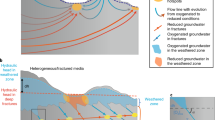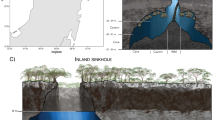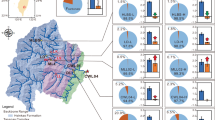Abstract
Deep subsurface microbial communities1 are believed to be supported by organic matter that was either deposited with the formation sediments or which migrated from the surface along groundwater flowpaths. Investigation has therefore focused on the existence of microorganisms in recently deposited or highly permeable sediments2,3. Fewer reports have focused on consolidated rocks4–7. These findings have often been limited by inadequate tracer methodology or non-sterile sampling techniques. Here we present evidence for the presence of spatially discrete microbial communities in Cretaceous rocks and advance a mechanism for the long-term survival of these subterranean communities. Samples were collected using aseptic methods and sensitive tracers8. Our results indicate that the main energy source for these communities is organic material trapped within shales. Microbial activity in shales appears to be greatly reduced, presumably because of their restrictive pore size9. However, organic material or its fermentation products could diffuse into adjacent, more permeable sandstones, where microbial activity was much more abundant. This process resulted in the presence of microbial communities at sandstone–shale interfaces. These microorganisms presumably ferment organic matter and carry out sulphate reduction and acetogenesis.
This is a preview of subscription content, access via your institution
Access options
Subscribe to this journal
Receive 51 print issues and online access
$199.00 per year
only $3.90 per issue
Buy this article
- Purchase on Springer Link
- Instant access to full article PDF
Prices may be subject to local taxes which are calculated during checkout
Similar content being viewed by others
References
Pederson, K. Earh-Sci. Rev. 34, 243–260 (1993).
Beeman, R. E. & Suflita, J. M. Microb. Ecol. 14, 39–54 (1987).
Balkwill, D. L., Fredrickson, J. K. & Thomas, J. M. Appl. Environ. Microbiol. 55, 1058–1065 (1989).
Amy, P. S., Haldeman, D. H., Ringelberg, D. B., Hall, D. H. & Russell, C. Appl. Environ. Microbiol. 58, 3367–3373 (1992).
Lipman, C. B. Science 68, 272–273 (1928).
Turner, H. G. Science 76, 121–122 (1932).
Farrell, M. A. & Turner, H. G. J. Bacteriol. 23, 155–162 (1932).
Fredrickson, J. K. & Phelps, T. J. in Manual of Environmental Microbiology (eds Knudsen, G., Stetzenbach, L., Mclnerney, M. M. & Walter, M.) 526–540 (Am. Soc. Microbiol., Washington, 1996).
Fredrickson, J. K. et al. Geomicrobiol. J. (in the press).
Kauffman, E. B. in Treatise on Invertibrate Paleontology A (eds Robinson, R. A. & Teichart, C.) 418–487 (Geol. Soc. Am., Boulder and Univ. of Kansas, Lawrence, 1979).
Pegram, P. thesis, New Mexico Inst. Mining and Technol. (1995).
Chambers, L. A. & Trudinger, P. A. Geomicrobiol. J. 1, 249–293 (1979).
Sharma, P. K. & Mclnerney, M. J. Appl. Environ. Microbiol. 60, 1481–1486 (1994).
McMahon, P. B. & Chapelle, F. H. Nature 349, 233–235 (1991).
McMahon, P. B., Chapelle, F. H., Falls, W. F. & Bradley, P. M. J. Sedim. Petrol. 62, 1–10 (1992).
Chapelle, F. H. & Lovley, D. R. Appl. Environ. Microbiol. 56, 1865–1874 (1990).
McKinley, J. P. et al. Geomicrobiol. J. 14, 23–39 (1997).
Fossing, H. & Jorgensen, B. B. Biogeochemistry 8, 205–222 (1989).
Ulrich, G. A., Krumholz, L. R. & Suflita, J. M. Appl. Environ. Microbiol. 63 (in the press).
Author information
Authors and Affiliations
Rights and permissions
About this article
Cite this article
Krumholz, L., McKinley, J., Ulrich, G. et al. Confined subsurface microbial communities in Cretaceous rock. Nature 386, 64–66 (1997). https://doi.org/10.1038/386064a0
Received:
Accepted:
Issue Date:
DOI: https://doi.org/10.1038/386064a0
This article is cited by
-
New insights into the coal-associated methane architect: the ancient archaebacteria
Archives of Microbiology (2024)
-
A glimpse of the paleome in endolithic microbial communities
Microbiome (2023)
-
Carbon fixation rates in groundwater similar to those in oligotrophic marine systems
Nature Geoscience (2022)
-
Distinct deep subsurface microbial communities in two sandstone units separated by a mudstone layer
Geosciences Journal (2020)
-
Differential depth distribution of microbial function and putative symbionts through sediment-hosted aquifers in the deep terrestrial subsurface
Nature Microbiology (2018)
Comments
By submitting a comment you agree to abide by our Terms and Community Guidelines. If you find something abusive or that does not comply with our terms or guidelines please flag it as inappropriate.



